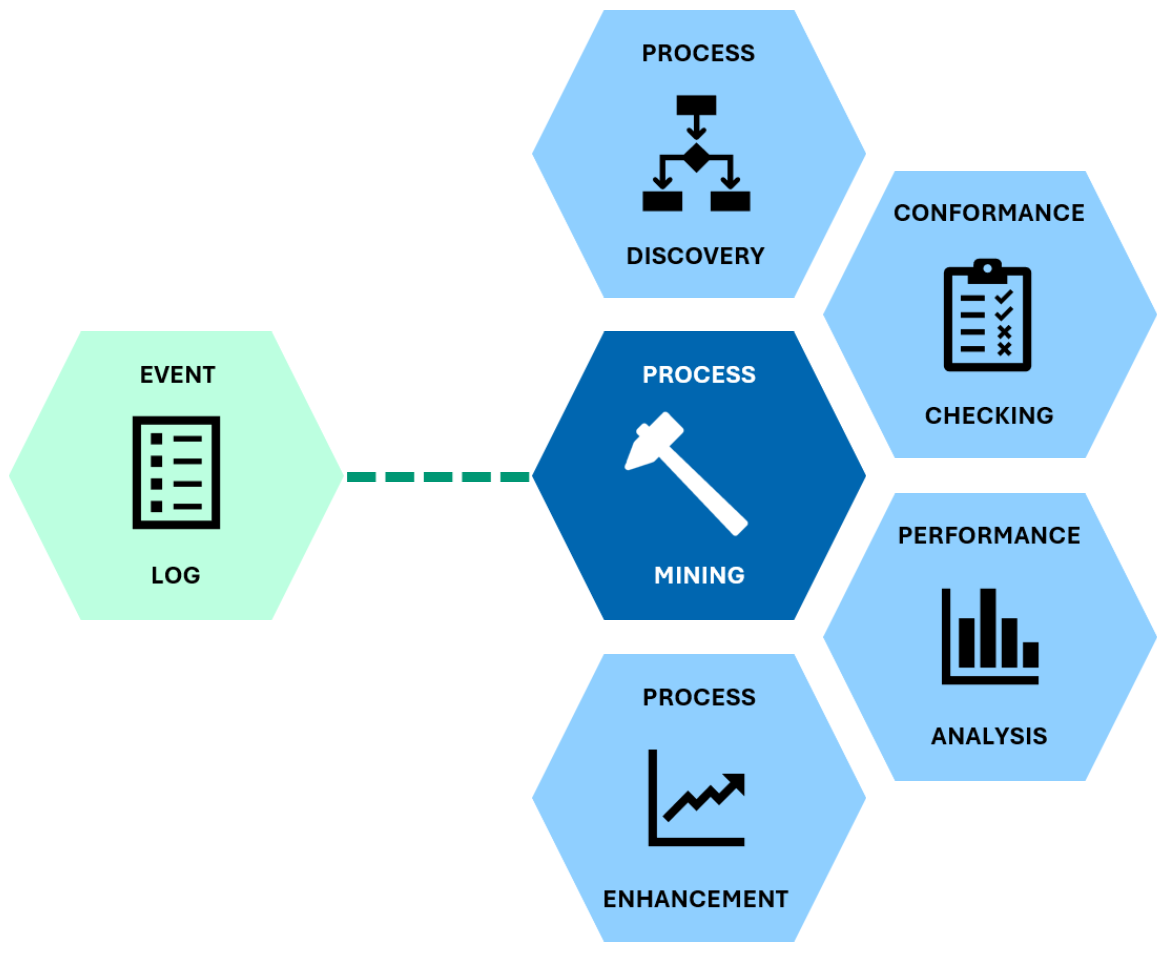Found this helpful? Share it with peers.
Introduction
Process mining helps organizations understand how their business processes actually run, not how they think they run. Companies today generate enormous amounts of data every day. Every task completed, transaction processed, or request handled leaves a trace – tiny records that, when pieced together, form the bigger picture of how a business operates. Yet despite this abundance of information, many organizations still struggle to put it to good use when it comes to refining operations or cutting inefficiencies.
This is where process mining makes a difference. It bridges the gap by taking data from information systems and using it to map, analyse, and enhance actual business processes. Instead of relying on assumptions or theoretical models, process mining uses real data to highlight what’s working, what isn’t, and what could be improved. This guide explains what process mining is, how it works, and how it helps organizations uncover hidden inefficiencies and make smarter, data-backed decisions. Whether you’re new to the topic or looking to strengthen your process improvement strategy, this is your complete starting point.
What Is Process Mining?
Process mining is a data-driven technique that analyzes event logs from business systems to visualize how processes actually work. It reveals the real flow of activities , highlighting bottlenecks, deviations, and inefficiencies.
Unlike traditional process analyses, often relying on assumptions or interviews, process mining gives an objective view rooted in real system data. This allows organizations to more accurately identify inefficiencies, streamline operations and make better informed decisions about how to improve performance moving forward.
Key Concepts in Process Mining
Process mining turns fragmented data into a comprehensive view of your operations, one that can be analysed, measured, and improved. Here are the core elements that make this possible:
Event logs
Event logs are digital records that show when and how steps in a process take place. The systems you use generate these logs automatically during day-to-day operations and serve as raw input for process mining.
Process Discovery
This is the act of creating a process model based on the real-world data extracted from the event log. It allows teams to uncover the actual flow of work, often revealing hidden inefficiencies and deviations from the expected behavior.
Conformance Checking
Conformance checking compares the discovered process model to an expected or ideal process to identify deviations. This is particularly useful for ensuring compliance with internal standards, policies, or regulatory requirements.
Performance Analysis
Performance analysis highlights bottlenecks, repetitive steps, and other inefficiencies that can be optimized for smoother, faster operations. By tracking key process metrics continuously, businesses can detect performance issues and make adjustments to enhance productivity.
Process Enhancement
Once insights are gathered, organizations can use these to redesign and refine their processes. This could encompass anything from simplifying workflows, reducing delays, or introducing automation to cut costs and improve process speed.
Hint: For a closer look at the process mining terminology, check out our cheatsheet on process mining fundamentals.

Core Capabilities of Process Mining
How Does Process Mining Work?
Process mining works by using real data from your IT systems to map how business processes actually happen.
Here’s how it works step by step:
Step 1: Capture digital footprints
Every action, from a transaction to an approval, leaves a trace in systems like ERP or CRM. These event logs form the foundation of process mining.
Step 2: Map and visualize processes
The extracted data is transformed into a process map showing how work truly flows, including variations and deviations from the intended process.

Process flow visualization based on recorded event data
Step 3: Identify inefficiencies
By analyzing the model, you can pinpoint delays, bottlenecks, or unnecessary steps that slow operations or waste resources.
Step 4: Improve and monitor continuously
Insights from process mining guide process optimization. Continuous monitoring helps measure improvements and sustain efficiency over time.

Dashboards with key process metrics and performance trends
Key Benefits of Process Mining
Boost Efficiency and Reduce Costs
Process mining shows where processes waste time or resources. With the help of these, businesses can reduce cycle times and improve resource utilization, which directly results in reduced operational costs.
Enhance Compliance and Risk Management
Clear process insights help teams spot compliance issues before they grow and address risks early. Process mining can ensure that operations stay aligned with required standards by offering visibility and transparency into process flows. With everything tracked step by step, it is easier to follow regulations and prepare for audits without scrambling. In addition, you can reduce the likelihood of costly penalties your company might face.
Drive Data-Driven Decision Making
Instead of relying on intuition or outdated data, businesses can use real-time data and accurate information. They can see the full picture, focus on problem areas, reduce uncertainty and make changes with confidence.
Improve Customer Experience and Increase Agility
Customers notice when processes work well. Clean, efficient processes help teams respond quickly and deliver more reliably by reducing the risk of errors. With the help of process mining, the agility of your organization can also be enhanced. When customer needs or market conditions change, it is easier to adjust without causing delays.
Gain Greater Transparency and Faster Issue Detection
One of the greatest things about process mining is that you get to watch your business processes work, rather than having to go off assumptions. This level of transparency is so important because it gives businesses a clear picture of what is actually going on. Whether it’s a point where things get stuck, a place where mistakes just keep happening, or just areas that are just not performing the way you expect them to, it helps you catch issues early.
Reduce Manual Effort and Drive Automation
Many tasks still rely on repetitive manual work. Process mining points out where automation can help, cutting down on human errors, speeding things up, and giving teams more time to focus on what matters.
Foster Better Collaboration Across Departments
Many businesses struggle with cross-functional communication and collaboration. Process mining offers a shared, data-driven view of processes. When everyone can see how a process flows, it is easier to coordinate. Teams understand each other’s roles, how their work affects others and can solve problems without stepping on each other’s toes.
Hint: Thinking about applying these benefits to your business processes? Check out the Process Mining module we offer for ADONIS
Enhancing Process Mining with Process Intelligence
What is Process Intelligence?
Process intelligence builds on process mining by adding more depth. Instead of just showing what’s happening in a process, it helps explain why. With process intelligence, we can utilize technologies like machine learning and AI to extract more insights from the data. Through it, we not only visualize processes but also predict future trends, identify hidden patterns, and give intelligent recommendations to improve performance. It is an intelligent assistant that helps you better manage your business processes.
How It Builds on Process Mining
Process mining shows how work flows through systems. Process intelligence takes that further and analyses why certain patterns emerge. For example, if a task is repeatedly delayed, process intelligence can tell you whether it’s due to resource shortages, system slowdowns, or other causes. These insights help teams move from reaction to prevention.
Why It Matters
Process mining shows you the data, but process intelligence helps you make sense of it. Combining the two means:
- Deeper understanding: Go beyond visualizations to get context behind performance.
- Predictive insights: Spot potential issues before they escalate.
- Smarter decisions: Use AI-driven suggestions to adapt faster and improve continuously.
Together, they form a strong foundation for scaling process optimization with confidence.
How Process Mining Fits with Other Business Techniques
Process mining connects naturally with other business improvement methods. Understanding how it compares and complements them helps organizations build a stronger optimization strategy.
Process Mining vs. Data Mining
While data mining looks for general patterns and correlations in large datasets, process mining focuses on how processes actually unfold over time.
Data mining might tell you what customers are likely to buy, while process mining shows how the order-to-cash process runs and where it slows down.
Process Mining and Task Mining
Task mining zooms in on individual user activities, such as clicks, keystrokes, or screen actions, to reveal inefficiencies at the micro level.
Process mining, in contrast, provides the macro view across systems and departments. Together, they offer a complete picture: how tasks fit into the larger business process.
Process Mining and BPM (Business Process Management)
BPM designs and manages process models, but often relies on assumptions about how work should flow.
Process mining validates those models with real data, showing how processes perform in reality and identifying gaps between design and execution.
Process Mining and RPA (Robotic Process Automation)
RPA automates repetitive manual tasks, but without visibility, it can target the wrong steps.
Process mining identifies the best automation opportunities and monitors performance once bots are deployed, ensuring automation delivers measurable value.
Common Challenges and How to Overcome Them
Even though process mining offers powerful insights, success depends on data quality, interpretation, and execution. Here are the most common challenges and our best-practice strategies on how to solve them effectively.
1. Misconceptions About What Process Mining Can Do
Some expect process mining to instantly fix inefficiencies or replace strategy. In reality, it’s a diagnostic tool. It shows where problems are, but not how to manage people or redesign systems.
Solution: Combine process mining with process management and change initiatives. Use its insights to guide strategy, not replace it.
2. Poor Data Quality and System Integration
If event logs are incomplete, inconsistent, or stored across multiple systems, insights will be unreliable.
Solution: Define clear data collection standards, ensure logs capture all key activities, and integrate systems through APIs or data warehouses for consistency.
3. Lack of Organizational Readiness
Without stakeholder buy-in or proper training, insights may never translate into improvements.
Solution: Start with pilot projects that show measurable ROI, communicate benefits clearly, and invest in skills that connect data insights to process action.
Summary – Turning Data into Actionable Process Insights
Process mining transforms raw operational data into clear, actionable insights. By showing how processes really run, it helps organizations uncover inefficiencies, reduce costs, and improve performance. All based on facts, not assumptions.
It doesn’t replace business strategy; it strengthens it. With ongoing monitoring and data-driven visibility, process mining enables teams to continuously refine their workflows and adapt faster to change.
In a world where every process leaves a digital footprint, process mining turns complexity into clarity — and clarity into competitive advantage.




